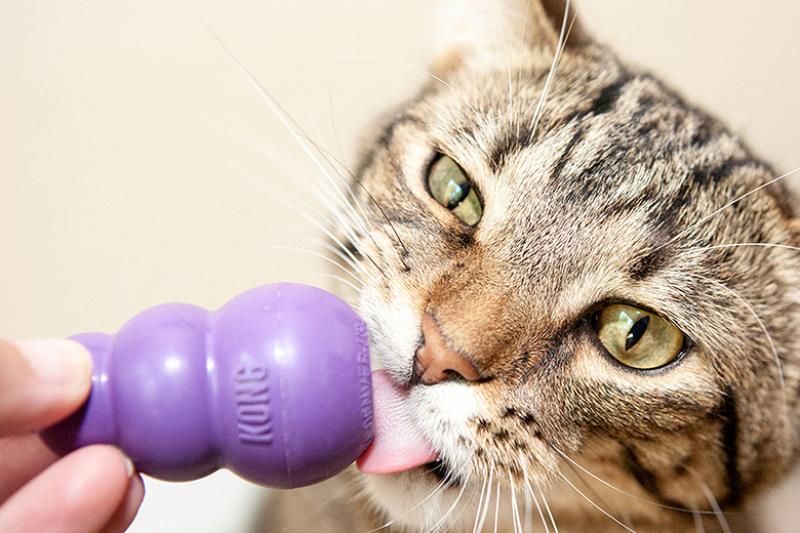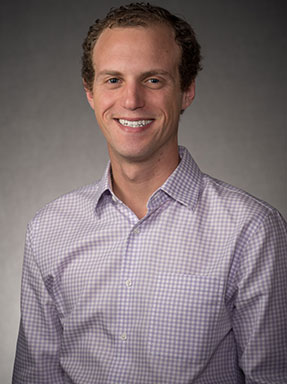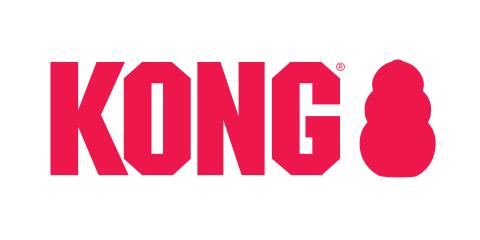Engineering, Business Students Partner to Create Cat Toy

Engineering assignments may not be easy, but in Maxwell Smith’s experience, they typically have been clear cut. Last year, for example, he was tasked with designing a robot that can ferry a container of food from one location to the next.
This year, some of his classmates are building a sound monitor. Others have to create a drone that can fly in the air and submerge in water. But Smith, a University of Denver senior, is confronting a challenge a bit more abstract and historically difficult.
He has to design something a cat would enjoy.
“It’s an eye-opener in what it means to be an engineer,” Smith says. “It’s different than any other class I’ve taken at DU and different, I think, than the typical college engineering course.”
The product (and its notoriously finnicky target audience) is part of Smith’s senior design project, a cornerstone of the curriculum at the University of Denver’s Ritchie School of Engineering and Computer Science. Before collecting their diplomas, every engineering student — regardless of whether they specialize in the electrical, mechanical or computer aspect — partners with a few classmates to solve a specific customer problem, often for an existing company.
“This is one of the things that makes DU different than other engineering schools,” says Graham Parkinson, a visiting teaching assistant professor advising Smith’s team. “We expose students to the cross-disciplinary nature of the engineering profession earlier on. Rather than launching their careers and having to figure it out then, they’re getting this experience now.”
Over the course of three quarters, Parkinson says, students become the teachers. Each team is self-directed and becomes the expert on their specific project. Parkinson considers the experience a stepping-stone into the professional world. Each student grows academically, personally and professionally, gaining an understanding of what it means to work in a consumer-facing industry.
For their capstone, Smith and fellow seniors Aubreigh Zorgdrager, Will Nafziger and Nick Kearns will try their hands at researching, prototyping and developing a cat toy for KONG Co. The partnership with the Colorado-based firm comes from Michael Caston’s search for a collaborator that can offer an achievable project for college students and benefit from the results.
“It’s an opportunity for students to learn about nondisclosure agreements, noncompete agreements, contracts, collaborating across disciplines, building their portfolios, validating their skill sets and validating their time,” says Caston, a professor of the practice and executive director of the Ritchie School’s Innovation Floor. “It’s exciting for it to come together in a way that’s beneficial for everybody.”
Over the years, Caston has shaken hands with plenty of companies eager to give students a hands-on experience in innovation. But when KONG suggested adding market research to the project, Caston turned to his colleague across campus, Melissa Akaka, an associate professor at the Daniels College of Business.
For years, Akaka and Caston have worked together to paint students a more complete picture of the iterative process. As a guest lecturer in Akaka’s classes, Caston introduced business students to prototyping. Akaka returned the favor, talking to engineers about understanding their customers.
“I love increasing and raising awareness around the importance and impact of consumer research,” says Akaka, who also co-directs the Consumer Insights and Business Innovation Center (CiBiC). “Very often we will find managers across all types of organizations who will make decisions based on their assumptions and who don’t take an empirical, data-driven approach to thinking through how somebody else may feel about it or what the competition is like out there.”
KONG’s desire to survey the marketplace and discover what’s trending brought Taylor Osicek to the table. During fall quarter, Osicek, a graduate student in the marketing program, has been conducting research to help the company better understand pet owners and the competitive landscape for pet products. She’s spent time browsing the websites of KONG’s competitors, dissecting different toys and seeing the ways they jive with market trends.
“There really is an evolving shift from pet owners to pet parents,” she says. “It’s been very cool to analyze the cultural shifts and create potential product changes for KONG that will have a positive impact on their financial results as well.”
The project has allowed Osicek to combine educational and work experiences, adding real-world applicability to her marketing degree.
CiBiC has long been a bridge between the DU campus and the business world, says Ali Besharat, the center’s co-director and an associate professor at Daniels. It has consulted on internal projects, from the campus shuttle to the new James C. Kennedy Mountain Campus. Just as important, it has allowed students to sharpen their skills and discover their passions through projects with various clients, KONG among them.
“That’s why I think this speaks to the 4D Experience for students,” Besharat says, referring to a DU initiative centered on advancing intellectual growth, exploring character, promoting well-being, and pursuing careers and lives of purpose. “It’s definitely beyond a class experience. It’s something they can experience in the real world: how they engage with companies, how you deliver meaningful findings, and making an impact on the business community.”
Annette Dennison, a product manager at KONG, has felt that impact firsthand. DU’s business and engineering students have brought fresh eyes and a fun energy to the table, she says.
“They’re not embedded in the industry, they don’t really know our customer base, they don’t have any angles. They’re just coming at it from a very pure standpoint,” she says. “They’re enthusiastic, which is awesome. It’s energizing.”
Osicek’s market research is informing Smith and his classmates as they create a preliminary design of the cat toy.
“I thought it was really eye-opening to see the in-depth technical work that went with the marketing research,” Smith says. Meanwhile, the team is doing its own research, disassembling other cat toys to understand how they function.
By spring, they hope to convert countless ideas and notebook sketches into a product they can build, test and ultimately deliver to KONG. They’ll present their ideas to the DU community at an open house and expo at the end of the academic year.
KONG may or may not bring the idea to market, but regardless, Smith and Osicek say the project has taught them a great deal about relationships, deadlines and demands of the business world.
“It’s been really rewarding to help a local business that, although extremely dominant in the toy space, doesn’t have access to some of the research resources we have available to us at CiBiC,” Osicek says. “To be able to comb through that data, synthesize it and help them grow has been really rewarding.”




